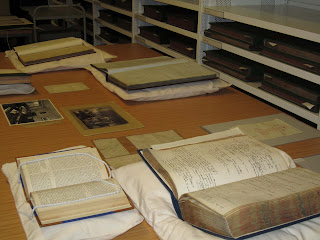I have recently been volunteering at LHSA to gain improved experience of cataloguing processes, and have been lucky enough to be given the responsibility of cataloguing the papers of Nancy MacLeod Nicol, which were gifted to LHSA following Nancy’s death in 2009. Nancy had a long career in nursing and nursing education, predominantly based in and around Edinburgh. She started her career as a student nurse at the Princess Margaret Rose Orthopaedic Hospital, Edinburgh, in 1956, and, following roles in various institutions, Nancy retired in 1994 from her role as Head of the Continuing Learning Department at Lothian College of Nursing and Midwifery (later merged into Edinburgh Napier University). Clearly committed to nursing, Nancy documented the entire span of her long career by retaining documents, photographs and ephemera relating variously to her own experiences in nursing, to colleagues and patients, and to the institutions where she was employed.
After Nancy moved into nursing education, she cultivated an interest in the history of nursing and midwifery education in the Lothian area. During 1992, Nancy embarked on research into the history of the Lothian College of Nursing and Midwifery, the roots of which lay in the many individual hospitals and groups in the Lothian area which once trained their own nurses and midwives. Nancy’s research particularly focused on the history of nursing and hospital badges, which hospitals often presented to nurses on completion of courses. Nancy’s aim was to locate a badge for each hospital in the Lothian area and to research the history of both the hospital and the badge. The collection includes individual photographs of each badge, along with manuscript material relating to the background of many of the badges.
When the cataloguing is complete, this will provide a useful additional resource to be used alongside LHSA’s own collection of nursing and hospital badges. In 2010, LHSA became involved in a collaborative project with the Royal Infirmary of Edinburgh and Edinburgh College of Art called ‘Unsung Heroes’, which focused on the LHSA collection of nursing badges. Nancy’s research provides fascinating context to the work carried out during the ‘Unsung Heroes’ project, and is likely to include images of badges which are not currently held in the LHSA collection.
By documenting her career progression over a period of almost forty years, Nancy’s legacy is the provision of a rich source of social history relating to the nursing profession during the latter half of the twentieth century. It has been a pleasure to organise these papers into a fascinating, enduring archive of a committed nursing career.
Simon cataloguing a photograph of a nursing badge





.jpg)





